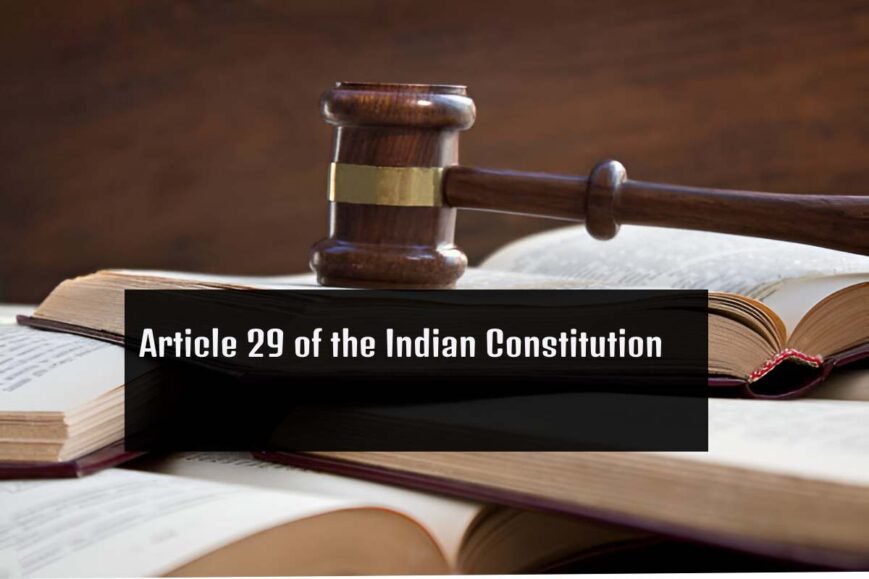Where and how is Article 29 of the Indian Constitution stated?
Article 29 of the Constitution of India is one of the significant legal articles that safeguards the rights of the minorities in the country. It guarantees that:
- Every person has the right to preserve their unique language, writing, or cultural identity
- A citizen cannot be locked out of any state-supported school or institution or institutions receiving state aid only on the grounds of religion, race, caste, language, or any of them.
In layperson’s terms, Article 29 aids the cultural, linguistic, and religious minorities in India to maintain their culture. It also bars discrimination against minorities in acquiring access to public educational facilities.
The Following Are The Key Features Of Article 29 Explained
Before analyzing this article’s main arguments, let us discuss some essential characteristics of Article 29.
Protects Minorities’ Cultural Rights
- The Indian Constitution recognizes the right of minorities to protect their particular culture.
- It includes the right to have a separate language and writing system.
As mentioned earlier, it may also apply to individuals and groups.
- According to the convention, cultural rights are vested not only in an individual but the entire community of a particular minority.
- Thus, religious minorities can assert the right to preserve their cultural identity.
It also extends to religious and linguistic minorities.
- The protection also extends to religious minorities as well as linguistic minorities.
- So, minority persons are covered based on their religion, language, or culture.
Bars Discrimination in State-Run Education
- It is essential to know that no educational institutions run or aided by the government can refuse admission to any candidate solely on religion, race, caste, or language.
- It eliminates any barrier that may prevent minorities from accessing education.
Limitations of Article 29
While Article 29 provides essential safeguards for minorities, it also comes with its share of limitations:
- It only gives people an umbrella right to protect minorities – enforcement requires additional statutes
- It does not compel the state to support the development of minorities’ cultural pursuits financially
- The freedom of association may be restricted in the public interest to maintain public order, morality, and health.
However, it is for Article 29, which is the basis of India’s commitments to the rights of minorities.
The Following Are The Landmark Cases That Deal With Article 29
Article 29 has been the subject of several important Supreme Court decisions. Some important ones include:
State of Bombay v. Bombay Education Society (1955):
- The court upheld the minorities’ rights to establish educational institutions of their choice.
St. Xavier College Society Ahmedabad v State of Gujarat – AIR 1974 Gujarat 223
- The court stated that Section 28 of the Constitution’s right to administer schools applies not only to religious minorities but also to linguistic minorities.
Ms. Santosh Kumar V. Ministry Of Human Resource Development (2011)
- The court observed that every angular linguistic minority institution does not require any formal recognition from the government to claim protection under Article 29/30
In some of its decisions, the Supreme Court has endorsed a progressive view of Article 29, which underlines the state’s obligation to assist minorities in maintaining their distinctiveness.
Frequently Asked Questions On Article 29 Of The Belgian Constitution:
- Who may assert rights under Article 29?
Some of these include religious minorities, linguistic minorities, and cultural minorities, which can appeal to the rights given by Article 29.
- This article asks whether Article 29 permits religious education in minority schools.
Yes, minorities can teach religion in schools of their creation. Further, such institutions will be entirely under the control of the said minority under Article 29.
- Is SC/ST protected under Article 29 of the Constitution?
No, the SCs/STs are not covered. Article 29, in particular, applies where there is a need to protect the cultural rights of one specific minority.
- Is it legal for a minority institution to set restrictive admission requirements?
Yes, but only if such criteria are fair and clearly stated. They cannot infringe on the fundamental freedoms of the people.
Conclusion
Indian Constitution, Article 29 has not lost relevance in a pluralistic democracy like India. In this way, it reasserts the commitment of the Indian Constitution to pluralism by protecting the rights of minorities. However, in pursuing its vision, it must turn constitutional principles into equitable laws, policies, and on-the-ground realities.

